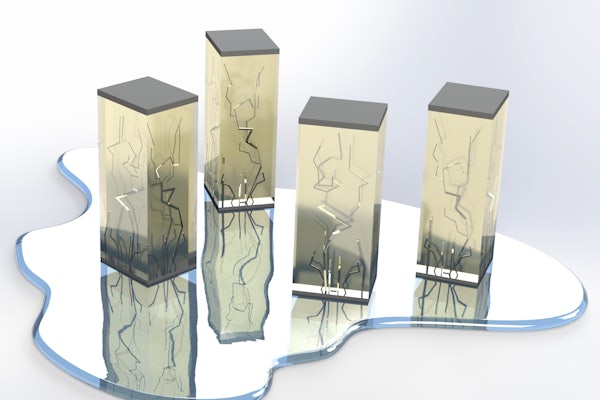New study shows similarity between solid state and liquid state electrolytes used in batteries
Peng Bai’s deciphering the root cause of safety issues in solid-state batteries

New research at the McKelvey School of Engineering at Washington University in St. Louis is the first to show that a solid-state electrolyte has a high level of similarity to liquid electrolytes, which is good news for designing safer and more efficient solid-state batteries based on reliable mechanistic knowledge.
“Our results reveal surprising similarities between the liquid and the solid electrolytes, and that allows us to borrow some ideas from the successful liquid electrolytes to help our design of the solid electrolytes,” said Peng Bai, assistant professor of energy, environmental & chemical engineering. “Before our work, solid electrolytes, at least the ceramic ones we studied here, are considered distinctly different from their liquid counterparts.”
Batteries power so much of our lives, so finding new improvements will have a drastic societal impact, Bai said. A promising route is the development of a full solid-state battery. A key component is the electrolyte in the center of the battery which allows ion movement between the electrodes. Here, the traditionally used liquid electrolyte is replaced with a solid and coupled to a metal electrode. This not only boosts the amount of energy stored but also leads to a potentially safer battery. However, an increasing number of reports about solid-state batteries tell a story of a key barrier, known as the critical current density (CCD), beyond which small tree-like structures called dendrites grow, resulting in battery failure. These reported CCDs are relatively low, which hinders fast charging and compromises further development of solid-state batteries.
“The CCD of solid-state electrolytes is a mystery. We are working to reveal why it exists, what its true physics are, and how it changes under different operating conditions,” said Bai, the principal investigator of this project and corresponding author of the paper published in ACS Energy Letters on April 12, 2023.
“Our discovery shows that the magnitude of CCD is linked to the thickness of the solid electrolyte, similar to the limiting current in liquid electrolytes that are well-known to have thickness dependence,” he said. “If you can make the solid electrolyte thin enough, we can get away from this CCD issue, therefore avoiding dendrite growths and the internal short-circuiting.”
Experimental innovations involved in this study include taking a standard pellet, a small circular disc fully densified by controlled sintering of ceramic powders, and precisely cutting it into multiple smaller pieces. The pieces were then tested using an electroanalytical technique different from those commonly used.
“These child samples from the same mother pellet were almost identical,” Bai said. “Testing hundreds of these ideally consistent miniature samples made the results we obtained more reliable and the statistics more meaningful.”
Rajeev Gopal, a doctoral student in Bai’s lab and first author of the paper, said this study can be a real difference-maker.
“Our work can shed light on the mysterious phenomenon of dendrite initiation at the CCD. The statistical trends we unveiled here will help predict and ultimately mitigate this type of growth, increasing the feasibility of these electrolytes in real-world batteries,” Gopal said.
Gopal R, Wu L, Lee Y, Gua J, Bai P. Transient Polarization and Dendrite Initiation Dynamics in Ceramic Electrolytes. ACS Energy Letters, April 12, 2023, DOI: 10.1021/acsenergylett.3c00499.
This research was supported by the National Science Foundation (2203994) and by a seed grant from the Washington University in St. Louis Office of Vice Chancellor for Research.





